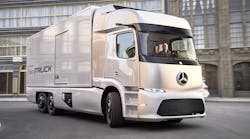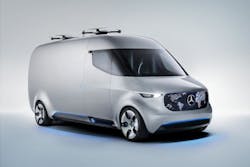HANNOVER, GERMANY. Advanced truck and bus technology for urban environments have taken center stage for Daimler at IAA 2016, the world’s largest commercial vehicle show. Having introduced its autonomous long-haul truck technology at the last IAA show in 2014, this time Daimler’s truck group rolled out a concept “Urban eTruck” with a 200 km range, while it’s van division showed an always-connected light vehicle meant to integrate last-mile delivery into advanced supply chain distribution systems. Using technology first shown in its Future Truck back in 2014, Daimler’s Mercedes-Benz Bus group this year also premiered the MB Future Bus with autonomous driving capability.
The Mercedes-Benz Urban eTruck is a fully electric 6x2 cabover with refrigerated body and 26-ton GVW. Power is delivered by two electric motors mounted at the drive wheel ends. A modular battery package design allows users to specify the proper storage capacity for their individual operations, with the standard three-battery module providing a range of up to 200 km, according to Daimler. A more compact two-battery module offers increased payload for shorter distances, and a four-battery package extends range at the cost of carrying capacity. All three rely on regenerative braking to recharge the batteries during operation.
Inside the concept Urban eTruck, twin 12-in. displays provide all control and operating information while automated drive controls adjust vehicle speed and braking based on actual road and traffic conditions. Battery-charge state and use forecasts are also always displayed, allowing drivers to choose from power, normal and “eco” drive modes depending on available battery power and need.
Central to the Urban eTruck’s efficiency is full integration with Daimler’s FleetBoard telematics system. It not only allows dispatchers to remotely monitor the truck’s operations, but helps them plan routes and loads to maximize the electric truck’s efficiency.
Daimler said standard production of this type of urban truck “would be conceivable from the start of the next decade.”
Similar but in a smaller package, the Mercedes Benz Vision Van is a concept vehicle designed to function as an element in an integrated and digitally connected supply chain system. An electrically powered zero-emissions vehicle with a range of up to 270 km, it is intended for last-mile deliveries completed by autonomous drones. It functions as part of a fully automated cargo management system that picks orders, sequences packages, optimizes routes and automates vehicle loading.
The van’s interior workspace uses a joy-stick control, eliminating steering wheel, pedals and center console for a large driver work area.
Building on the autonomous driving technology introduced in the Mercedes-Benz Future Truck in 2014, the MB Future Bus takes that technology a few steps further for urban applications. Its ‘CityPilot” system can operate fully autonomously for up to 20 km, handling all steering, accelerating and braking by reading road signs and traffic lights, detecting obstacles and pedestrians and operating the bus doors at stops.
The concept bus is based on the current MB Citaro bus, but employs an unusual passenger compartment design Daimler says is based on public parks and squares. Passengers can chose between a standing room only “express” area for short trips or a ‘lounge” with asymmetrically placed seating for longer ones.
Overhead consoles with 43-in. monitors keep passengers fully informed and entertained.
While the concept bus shown at IAA is powered by MB 6-cyl. diesel, the company says it could also be fitted with its M936G natural gas engine or a forthcoming battery-powered electric drive for city buses due in 2018.




